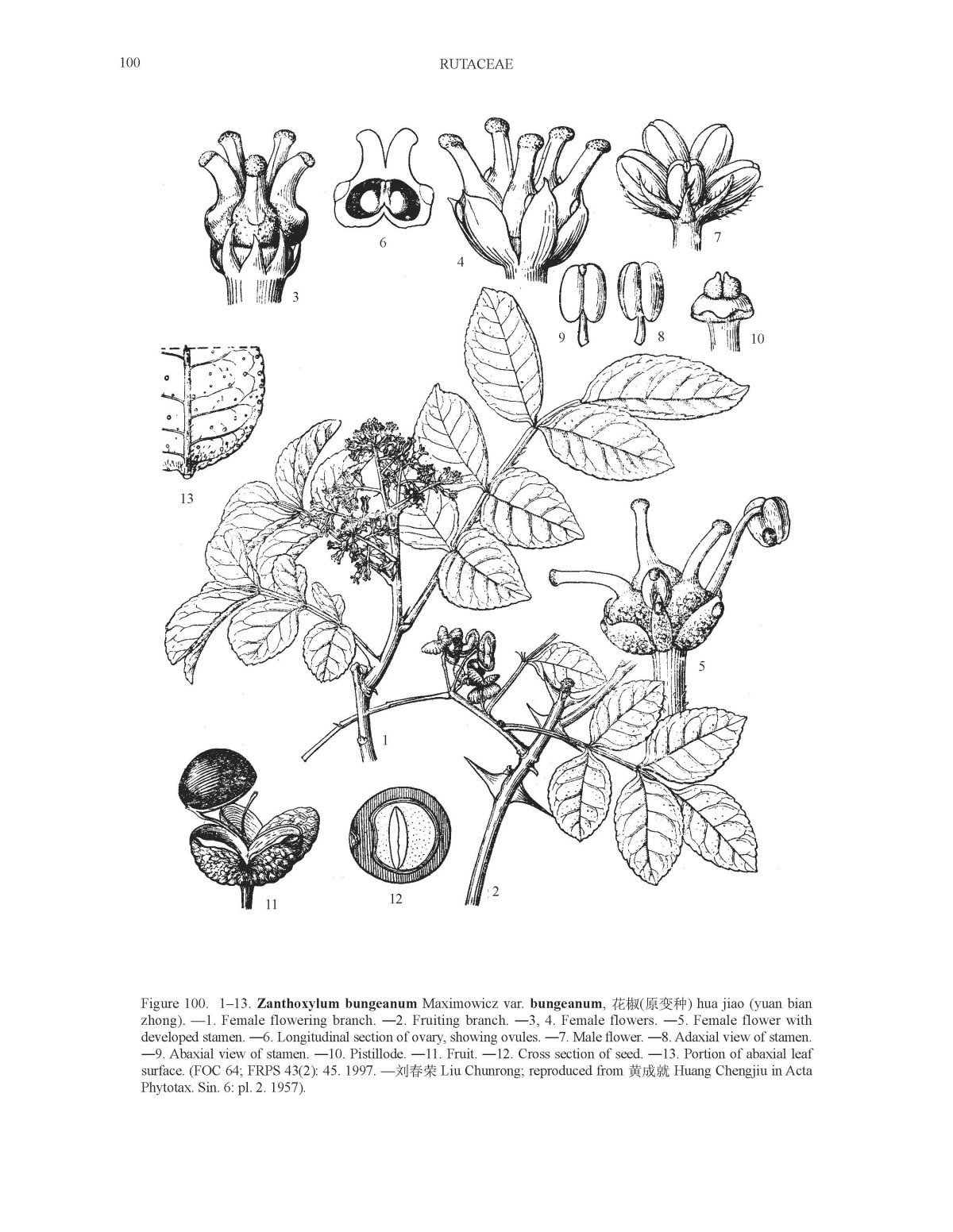Zynthoxylum bungeanum Maxim. - Rutaceae - 花椒 hua jiao (chin.), Sichuan pepper, Szechuanpfeffer
Deciduous tree, up to7m tall, native to China, Bhutan; stems and branchlets with prickles; leaves 5-13-foliolate, leaflets sessile, opposite, ovate, elliptic, or rarely lanceolate; inflorescences axillary but terminal on lateral branchlets; perianth in 2 irregular series or 1 series, with 6-8 yellowish green ± undifferentiated tepals, male flowers stamens 5-8, female flowers 2-5-carpelled; fruit follicles purplish red, 4-5mm in diam.
„The dried fruit follicles of Zanthoxylum bungeanum are used as a culinary spice and are particularly popular in Sichuan cuisine (Sichuan pepper). In Japan, Z. piperitum (Linnaeus) Candolle is sometimes similarly used.“
http://www.efloras.org/florataxon.aspx?flora_id=2&taxon_id=200012477
Main components of the essential oils from Z.bungeanum (red huajiao) were linalyl acetate (15%), linalool (13%), and limonene (12%); whereas linalool (29%), limonene (14%), and sabinene (13%) were the major components of Z.schinifolium fruits (green huajiao). „Despite the differences in major components, both species have six common compounds of top aroma character impact: linalool, α-terpineol, myrcene, 1,8-cineole, limonene, and geraniol. The tingling sensation of huajiao is caused mainly by the alkylamide hydroxy α-sanshool. The tingling compound decomposes easily under hydrolytic conditions or under UV light.“
[Yang, Xiaogen. „Aroma constituents and alkylamides of red and green huajiao (Zanthoxylum bungeanum and Zanthoxylum schinifolium).“ Journal of agricultural and food chemistry 56.5 (2008): 1689-1696]
The major compounds of an essential oil obtained by hydrodistillation of Zanthoxylum bungeanum Maxim. fruits were terpinen-4-ol (19.7%), 1,8-cineole (16.0%), p-cymene (7.9%), γ-terpinene (7.3%) and α-terpineol (7.2%).
[Gong, Youwen, et al. „Chemical composition and antifungal activity of the fruit oil of Zanthoxylum bungeanum Maxim.(Rutaceae) from China.“ Journal of Essential Oil Research 21.2 (2009): 174-178]
The essential oil of the fruits (hydrodistilled, yield of 2.9% w/w) mainly consisted of oxygenated monoterpenes and monoterpene hydrocarbons. The major compounds (GC/MS) were terpinen-4-ol (18.4%), 1,8-cineole (15.4%), limonene (7.4%), α-terpineol (5.7%), γ-terpinene (5.2%), terpinyl acetate (4.6%), and linalool (4.5%).
„The pericarp of Zanthoxylum bungeanum Maxim., belonging to the Rutaceae family, is commonly used as a flavoring and traditional Chinese medicine for its flavors and medicative characteristics in China. According to the theory of traditional Chinese medicine (TCM), the pericarp of Z.bungeanum Maxim. possesses the medical functions of warming the spleen and stomach to relieve pain and killing parasites to relieve itching, and it is also effective for the therapy of pathogenic wind, epigastric pain, eczema, pruritus, fungal infection, diarrhea, and dysentery…“
[Lan, Yi, et al. „Cytotoxicity and enhancement activity of essential oil from Zanthoxylum bungeanum Maxim. as a natural transdermal penetration enhancer.“ Journal of Zhejiang University SCIENCE B 15.2 (2014): 153-164] https://www.ncbi.nlm.nih.gov/pmc/articles/PMC3924391/
„…the major alkylamides in Z.bungeanum and Z.schinifolium oils were identified as hydroxy‐ε‐sanshool, hydroxy‐α‐sanshool, hydroxy‐β‐sanshool, hydroxy‐γ‐sanshool, hydroxy‐γ‐isosanshool, bungeanool, isobungeanool, and tetrahydrobungeanool… Z.bungeanum oils contained significantly (P less than 0.05) higher levels of hydroxy‐γ‐isosanshool, bungeanool, isobungeanool, and tetrahydrobungeanool, compared with Z.schinifolium oils.“
[Zhao, Zhi‐Feng, et al. „Characterization and comparison of the pungent components in commercial Zanthoxylum bungeanum oil and Zanthoxylum schinifolium oil.“ Journal of food science 78.10 (2013): C1516-C1522]
„The sanshools are the predominant class of long-chained polyunsaturated amides produced by the Zanthoxylum genus… These alkamide natural products are characterized by the presence of three conjugated double bonds at the Δ-end of the fatty acid chain. The nomenclature of the sanshools is such that the term “sanshool” refers to the non-functionalized isobutylamide group, with “hydroxy-sanshool” referring to the (2-hydroxy)isobutylamide congeners… Dried pericarps from Z. bungeanum MAXIM, referred to locally as red huajiao and internationally as Sichuan peppercorn, are ubiquitous in authentic Sichuan cuisine due to their distinctive taste and the unique numbing and tingling sensations that they impart from the collection of alkamides present. As the name suggests, the bungeanools were first isolated from the pericarps of this particular Zanthoxylum species… Structurally, the bungeanools are essentially partially saturated variants of hydroxy-γ-sanshool.“
[Chruma, Jason J., et al. „Polyunsaturated fatty acid amides from the Zanthoxylum genus–from culinary curiosities to probes for chemical biology.“ Natural product reports 35.1 (2018): 54-74] https://pubs.rsc.org/-/content/articlehtml/2018/np/c7np00044h

Zanthoxylum bungeanum var. bungeanum, Flora of China

Zanthoxylum bungeanum, Credit: Susan Kelley
http://www.efloras.org/object_page.aspx?object_id=91582&flora_id=800